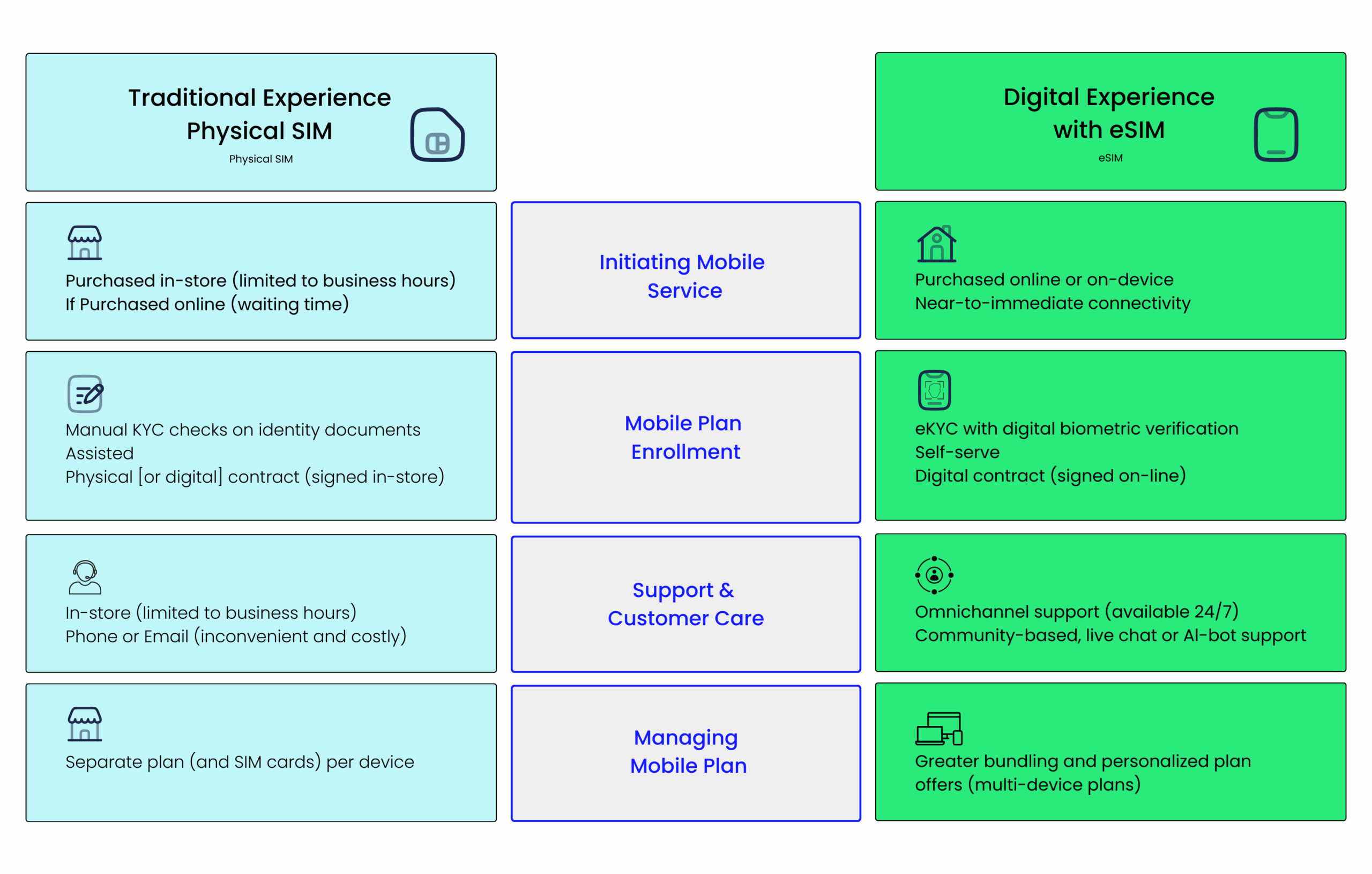
Yet as digital transformation accelerates, so too does the evolution of how users expect to connect. eSIM technology (embedded SIM), now integrated directly into devices, is quietly reshaping the mobile customer journey. With it, users can activate, manage, and transfer mobile plans entirely digitally — no more waiting for a card to arrive, no need for a SIM tray tool.
This shift isn’t just about convenience. eSIM unlocks new opportunities for operators and MVNOs to streamline onboarding, enable remote provisioning, and deliver seamless customer experiences across channels. While physical SIMs will continue to play an important role in many markets and device categories, eSIM brings new flexibility and agility for the future of mobile.
An eSIM is a programmable chip embedded directly into smartphones, tablets, and other connected devices. Unlike traditional SIM cards, which must be physically inserted and replaced, eSIM allows users to download and activate mobile network profiles remotely — no physical card required.
This means that connectivity credentials, which used to be tied to a plastic SIM, are now delivered over the air in a secure and seamless way. As a result, users can activate mobile service digitally, often within minutes, from virtually anywhere.
This innovation transforms onboarding into a fully remote experience — faster, more scalable, and far more user-friendly than conventional methods. It eliminates logistical delays, shortens time-to-service, and gives users greater control over their mobile connectivity without needing to visit a store or handle any hardware.

Activating a mobile line used to mean waiting for a SIM card delivery or visiting a retail store. With eSIM, the experience is streamlined and digital:
- Users simply scan an individual or generic QR code, or install a profile via an app
- Activation is completed within minutes
- No logistics, no delays, no physical handling
This stage of the eSIM customer journey brings immediate improvements in:
- Onboarding speed and simplicity
- First impressions and user experience
- Conversion rates and time-to-revenue for operators
The benefits are clear: faster activations, reduced churn, and lower operational costs.
Traditional SIM activations often required manual identity checks, leading to delays and increased fraud risk. eSIM onboarding changes that with:
- eKYC (electronic Know Your Customer) and biometric verification
- Digital contract signatures — no paperwork required
Users can now complete the entire onboarding process securely on their smartphones, in just a few taps. This strengthens:
- Digital customer flows and user satisfaction
- Regulatory compliance and fraud prevention
- Scalability across markets — without needing physical infrastructure
This is a significant step forward, particularly in regions with limited retail presence or logistics challenges.
Modern mobile users expect instant support — without being placed on hold or visiting a store. eSIM-native processes enable:
- Automated tools for activation and troubleshooting
- Chatbots and self-service apps offering 24/7 assistance
- Integrated support tied to the user’s account and active profile
This reduces friction, increases resolution speed, and improves overall customer satisfaction.
Users today own a growing ecosystem of connected devices — smartphones, tablets, wearables, laptops. eSIM supports this lifestyle by enabling:
- Multi-device plans linked to a single phone number
- Seamless switching between plans or networks via an app
- Remote provisioning across all devices, with no physical SIMs required
This flexibility is essential for the modern mobile experience, delivering convenience, control, and continuity across devices.

For mobile operators and MVNOs, the shift to eSIM is more than a convenience upgrade — it’s a strategic enabler for digital transformation. By embracing the eSIM customer journey, providers unlock new operational efficiencies and service opportunities.
eSIM empowers providers to:
- Automate onboarding and reduce activation costs
- Accelerate time-to-market with digital-only workflows
- Expand into new regions without investing in physical infrastructure
It also paves the way for innovative offerings, such as:
- On-demand roaming and custom data plans
- Instant connectivity for IoT and smart devices
- Embedded connectivity in wearables, vehicles, and beyond
For MVNOs, this translates into faster go-to-market timelines, improved customer retention, and differentiated value through digital-first service models.
The transition from physical SIMs to eSIM isn’t just a technical upgrade — it’s a complete reimagination of the mobile customer experience. From instant, remote activation to self-service support and seamless multi-device connectivity, eSIM aligns perfectly with today’s digital expectations.
For mobile operators and MVNOs, investing in a frictionless eSIM journey means more than just keeping up — it’s a way to lead. It strengthens digital branding, enhances agility, and positions providers to thrive in the evolving connectivity landscape.



